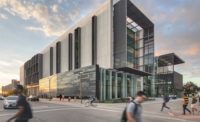When your campus is home to 27,000 students, indoor air quality is of the utmost importance.
The University of Arkansas, located in Fayetteville, has 100 buildings served by about 150 air-handling units, or AHUs, each designed to condition and filter campus airstreams. Moisture is an ever-present threat in air handlers, because the evaporator coil operates at a temperature less than the dew point. As moisture is drawn out of the air to produce cooler temperatures to room occupants, the condensation that results creates the perfect environment for mold and other harmful contaminants to flourish.
In 2008, facilities personnel at the university started getting complaints about biological growth accumulation on the air distribution registers in the Health, Physical Education, and Recreation Building. The 100,000-square-foot space has a heavy concentration of student activity rooms. It needed a remedy that could work in conjunction with the two AHUs, which produce a combined 42,000 cfm.
Simply steam cleaning the air registers was not enough. For a more permanent solution, facilities management turned to ultraviolet germicidal (UV-C) technology, which uses a 253.7-nm germicidal wavelength to eliminate biological growth that mechanical and chemical washing often misses. The RLM Xtreme fixtureless UV-C lamp system, manufactured by UV Resources, was selected for installation on two air handlers downstream of the coil that services the recreation building, ensuring that safe and clean air is delivered to students and faculty.
Over a three-month period of UV-C treatment, coil pressure drop decreased from nearly 1 inch to less than 0.8 inches of static pressure. Since the AHU fan didn’t need to strain to draw air through the plenum, facilities management were able to lower the brake horsepower by 1.311 and save roughly $1,077 a year in energy costs.
Want more HVAC industry news and information? Join The NEWS on Facebook, Twitter, and LinkedIn today!







